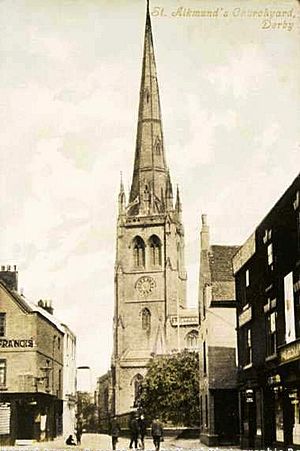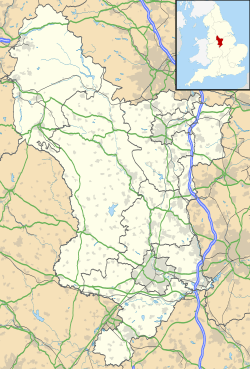St Alkmund's Church, Derby facts for kids
Quick facts for kids St Alkmund’s Church, Derby |
|
|---|---|

St Alkmund’s Church, Derby in 1906
|
|
| 52°55′36.48″N 1°28′42.96″W / 52.9268000°N 1.4786000°W | |
| Location | Derby |
| Country | England |
| Denomination | Church of England |
| History | |
| Dedication | Alchmund of Derby |
| Architecture | |
| Architect(s) | Henry Isaac Stevens |
| Groundbreaking | 6 May 1844 |
| Completed | 15 September 1846 |
| Construction cost | £7,700 (equivalent to £533,900 in 2021). |
| Demolished | 1968 |
| Specifications | |
| Height | 216 feet (66 m) |
Saint Alkmund's Church was a large church in Derby, England. It was built in the Victorian era, a time when Queen Victoria ruled Britain. The church stood in a special Georgian square, which was the only one of its kind in Derby. Sadly, the church and its churchyard were taken down in 1968. This was done to build a new road to help traffic move better in the city.
Churches dedicated to Saint Alkmund have been on this spot for a very long time, since the 800s! When the Victorian church was demolished, workers found old items. These included a stone sarcophagus (a type of coffin) and parts of a 4-metre (13 ft) tall stone cross. You can see these ancient treasures at the Derby Museum and Art Gallery today.
A new, modern church was built to replace the old one. It is located on Kedleston Road and is called St Alkmund’s (new) Church, Derby.
Contents
History of St Alkmund's Church
The church you see in old pictures was built in 1846. A famous architect named Henry Isaac Stevens designed it. It cost about £7,700, which was a lot of money back then! This church was built on the same spot where many older churches, all named after Saint Alkmund, had stood since the 9th century.
Building the Church
The church was made from ashlar stone, which is a type of finely cut stone. It was built in a Gothic style, which means it looked like old medieval cathedrals with pointed arches and tall spires. Inside, the church was very impressive. It had tall pillars and stone arches, with wide aisles and a large main area called a nave. The tall steeple (the pointed tower) was held up by flying buttresses, which are special supports that stick out from the walls.
The first stone for the church was laid on May 6, 1844. The completed church officially opened on September 15, 1846. The Bishop of Lichfield, a high-ranking church leader, was there for the opening.
A "Holy Spite" Spire?
Building the church caused some arguments among the Catholic people in Derby. The church's 216-foot (66 m) tall spire was built right in front of the Catholic St Mary's Church. Because of this, some people jokingly called the new Anglican church "The Church of the Holy Spite" for many years.
A famous Derby painter, Joseph Wright, was re-buried in St Alkmund's churchyard after the building was finished in 1846.
The Church's Surroundings
The church was surrounded by many two- and three-story townhouses. These houses lined the square and the churchyard. Other interesting buildings nearby included The Lamb Inn, a pub that opened in 1835 and even had its own brewery. There was also a sweet shop from the 1600s and several medieval shops near the Queen Street entrance. A famous historian, Sir Nikolaus Pevsner, described the area as a "quiet oasis," meaning it was a peaceful and special place.
Problems with the Spire
In the mid-1950s, people found out that the wooden parts holding up the steeple were bending and rotting. Because of this, the top 20 feet of the steeple had to be removed for repairs. There were plans to put a new top on the steeple, but it was never finished. Some of the decorative Gothic pieces on the roof were also taken off, but no one knows why.
Church Organ
The church had a new organ installed in 1858. It cost £250 and was built by a company called Forster and Andrews. However, this organ was later found to be not good enough. So, in 1888, a much bigger and better organ was put in. This new organ cost £1,200 and was made by Thomas Chambers Lewis.
A very famous French organ player, Alexandre Guilmant, gave a concert on this new organ on March 22, 1889. The organ was later changed a few times by John H Adkins in 1908, 1910, and 1938. You can find more details about this organ on the National Pipe Organ Register.
Demolition and New Church
In 1963, the Derby Council announced plans to improve traffic in the city. Part of this plan meant building a new road right through the church and its churchyard. Many people in Derby were very upset about this.
However, the council used a special order to buy the land, and the demolition of the church began in 1968. During the demolition, workers found the remains of the very first church on the site. They also found a stone sarcophagus, which many believe belonged to Saint Alkmund himself, and other old items. These discoveries are now on display at the Derby Museum and Art Gallery. Pieces of a 4-metre (13 ft) tall stone cross, carved with birds and animals, were also found and are now at the museum.
Today, the old church site is covered by Derby's inner ring road, called St Alkmund's Way (A601). There is very little left to show that a church once stood there, but a plaque was put up to remember its history.
A new, modern church with the same name was built on Kedleston Road in the early 1970s. This new church continues the legacy of St Alkmund's in Derby. You can learn more about it at St Alkmund’s (new) Church, Derby.
Images for kids
-
St Alkmund's Church has a spire in this painting by Robert Bradbury. This dates the painting as after 1845 and is in the collection of Derby Museum
-
Cross shaft from St Alkmund's Church at Derby Museum and Art Gallery.






